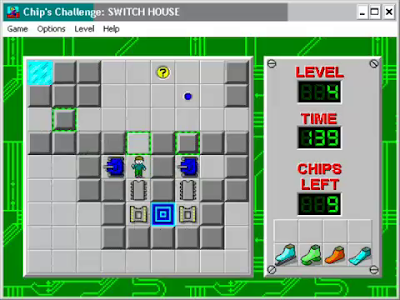Platform: Lynx, Dos, Windows
Developer: Epyx
Genre: Puzzle
Creator: Chuck Somerville
Chip's Challenge for any that are unaware was a 90's game where you played as the title character in a 2D overhead perspective, tile-based puzzle game. I first came to play it via Windows in the early 90's and became quickly hooked. It was a perfect time waster after school that I found a vastly more enjoyable alternative to Minesweeper. Part of why I liked it so much was how easy it was to learn, no instructions were needed as the brightly lit keys and chips clued the way forward. Practically any age group could play it and with many hint boxes in the early stages even the not-so-bright could catch on.
In Chip's Challenge you play as a highschool nerd named Chip McCallahan, Chip will do anything to be in The Bit Busters, a select computer club of which Melinda The Mental Marvel is leader. Judging by the cover, I guess Melinda is the object of Chip's affection but with the limited info given who knows. Melinda agrees for Chip to be a member if he can make it through her Clubhouse in one piece and collect all the computer chips. To complete a level you must collect all the chips before the time runs out, this is done by collecting keys and opening various doors, once none of the computer chips are left you stand on The Chip Socket, a dark and light blue coloured tile, and it'll transport you to the next level.
Initially the levels seem quick and easy but as you progress so does the difficulty. Trail and error is an obvious way to progress, while mentally picturing what has to be done before rushing around is also important. There's 148 levels and each has enough variety to keep the persistent gamer happy. If one seems kind of dull then the next ten will be more interesting, some may test your puzzle solving skills while others rely on fast paced action without hesitation.
You'll soon find green and black strips known as force floors as well as water traps, invisible walls and monsters, some of which need special shoes to manoeuvre past while others need fast evading. It should feel repetitive and tiresome but with an assortment of problems and special objects to acquire it stays enjoyable.
Overall it does feel rewarding when the level meter goes up and you can see the end in sight, as well as when the time meter is up and you've completed a level in record time. Besides that I'd say the summary sign that pops up when you've completed a level along with a shiny new four-letter password really reinforces that great sense of achievement. I know it might sound boring but as an old game it's simplicity comes with the territory, game designers couldn't do a hell of a lot back then.
As an old game it is clunky and the animation (or lack thereof) is jarring, even given the time you'd think they could have at least have animated Chip. But if you think of it as an alternative to the very select few puzzle games on the early Windows such as Mindsweeper, it's actually an easy stand out. It's a game you can picture as an early NES title before the system started pushing it's full 8-bit capability, it's basic but not so much as take away the feeling of being a legitimate game. There's enough difference between levels to not feel like Noughts and Crosses while enough variety of terrain to fend off growing bored from continuously collecting chips.

.jpg)







